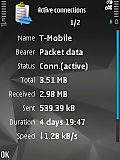
Most of the time, I am almost always-on with one device or another, which means the device has an IP address only for the time I use an application. A couple of hours is usually the longest time since once I come home, my Wifi network takes over and my N95 starts using the home network. In the past, I have tried how long I could stay online with the mobile before the connection with the wireless network (the PDP context) is dropped. And there are many reasons for "packet call drops": Mobile resets, application crashes, network resets, network not configured correctly for Inter-SGSN routing area updates, you name it. So there are many causes for the connection to drop at some point and to be reestablished. So beyond a couple of hours to a day was usually the max. These days, things have much improved. In my latest test, I've been always-on with my N95 for almost 5 days. Take a look at the picture on the left. The last screenshot I took shows the packet data connection online counter at 4 days 19 hours and 47 minutes. That's what I call really always online 🙂 BTW: The network under test was that of T-Mobile Germany. Let's see if they can keep up this reliability once they roll in new equipment…
One thought on “Being Really Always-On”
Comments are closed.
I work for an operator here in the UK and we pursposefully de-activate PDP contexts after 2 hours of inactivity (0 bytes transferred) or after 24 hours regardless of data transfer or not. The first one is to free up capacity on the SGSN (a bit historical now as capacity has increased a lot) and the second one is there in case someone forgets about their data session and they get an enormous bill afterwards (in case the application keeps sending/receiving data unattended).